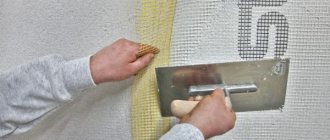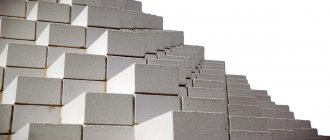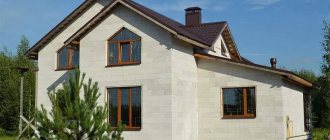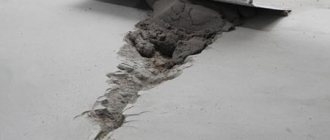Plastering the facade over insulation is used to level the surface of the structure, improve the technical properties of the material and protect it from the negative effects of the environment. Polystyrene foam, which is used for cladding buildings, has good thermal insulation properties, but at the same time it is fragile and short-lived. Mesh for plastering walls is a special building material that is made from various types of reinforcement with different cell sizes.
Purpose of reinforcing materials on the wall for plastering work
Plaster reinforcement is an effective, time-tested technology for improving the characteristics of a leveling coating.
Painting mesh for plaster performs the following functions:
- Helps create a coating layer of greater thickness than specified by the manufacturer. This allows you to solve the problem of uneven walls. Sometimes, to create a uniform and smooth surface, it is necessary to apply more mortar than the structure can withstand.
- Creates conditions for the formation of a solid layer, protects it from shrinkage cracks and their consequences. This is especially important for finishing ceilings, door and window openings. The reinforced mesh helps prevent peeling and subsequent collapse of the finish.
- Increases the durability of the finishing layer. Thanks to the mesh, the coating can withstand heavy loads. For example, this is important if cabinets or heavy shelves for books and other items are mounted on the wall. Thanks to the reinforcing layer, the load on the wall is reduced.
Reinforcement is subject to a solution of any composition whose thickness exceeds 3 cm.
Cases when you need a façade mesh for plaster:
- when performing work with a large thickness of the mixture - partially or over the entire base;
- if the building is located close to other buildings and complexes, which, in turn, have a vibration effect on it;
- if neighboring premises have undergone redevelopment and the specific weight of the structure has been redistributed;
- to modify the initial durability characteristics of the coating - increases the load-bearing capacity for placing attached household equipment and furniture.
Plastering the surface
After installing the beacons, you can proceed to the plastering process. Plastering walls on a grid is carried out in several stages, at each of which one layer of mortar is applied.
First stage. Plastering is usually carried out in 2 or 3 layers, depending on the material of the walls. The initial layer is applied by “spraying”. To do this, prepare a solution whose consistency should resemble sour cream. The finished mixture is poured over with a trowel or ladle in any order. The solution can be spread, but the first option is easier and faster. The applied mixture is leveled with a spatula. The thickness of the “spray” layer should be about 10 mm.
Throwing plaster on the wall
Second phase. After the first layer has completely dried, a thicker mixture of dough-like consistency is kneaded. The solution applied using a trowel is leveled with a rule, which is pressed against the beacons and pulled from the bottom up. This layer should completely cover the reinforcing mesh. After the solution has set, the profiles are pulled out and the remaining furrows are sealed.
Leveling the plaster layer using the rule
Third stage. The final procedure is the final leveling of the frozen surface. To do this, prepare a liquid solution and, applying it to the wall, rub it in a circular motion using a grater.
The above plastering technology is suitable for finishing any surface, regardless of what kind of reinforcing mesh is used.
Types of reinforcing mesh for walls
The mesh for finishing work acts as a frame that holds the entire structure from destruction.
Before using reinforcement, other building materials were also tested. Experts wanted to get strength, high adhesion, elasticity and durability from them. However, not all options survived testing. Special requirements are imposed on materials that are used for exterior finishing, because... Temperature changes, moisture and other climatic factors have a negative impact on the surface.
The following meshes are most often used for plastering facades:
- metal;
- fiberglass;
- polyurethane;
- fiberglass;
- lavsan;
- from modified basalt glass (only for wooden surfaces).
Metal construction reinforced mesh
Iron reinforcing material is produced in various variations. Each modification has its own characteristics and technical features.
Plaster mesh is distinguished according to the following characteristics:
- by weaving method and cell sizes;
- by the thickness of the rods and the method of processing them;
- according to composition and production method.
The advantages of metal reinforcing material include:
- high strength;
- possibility of use with any type of mortar and base (concrete, cement, clay, wood, etc.);
- strengthening effect on a layer of any thickness;
- the ability to cut the canvas with metal scissors or simple wire cutters;
- the ability to withstand foundation shrinkage and vibration from neighboring buildings.
The disadvantages included:
- the heavy weight of the iron sheet, because of this it cannot be used to reinforce thin walls or drywall;
- the ability of uncoated iron to deteriorate due to corrosion.
Metal mesh for reinforcing plaster is divided into several types:
- All metal expanded metal
. For its production, sheet material with a thickness of about 0.4-0.5 mm is used, in which cells are made in a checkerboard pattern. The resulting pattern is then stretched until it reaches a height of 1 mm and a width of 3 mm.
- Cold rope or galvanized
. During the manufacturing process, wires of the same thickness are intertwined. The cells will be in the shape of a rhombus or scales.
- Chainlink
- began to be called so in honor of its inventor Karl Rabitz, who patented it at the end of the 19th century. It is characterized by high strength, because the elements are connected to each other by welding.
Why do you need a basalt mesh?
Plaster with mesh will last longer and help protect the insulation from the negative effects of the environment. Basalt reinforcement appeared relatively recently and in terms of strength and reliability has surpassed fiberglass material, which for a long time occupied a leading position. Basalt reinforced mesh is resistant to ultraviolet rays and alkaline environments, and provides good adhesion to putty and plaster.
Due to its technical properties, it is often used to strengthen the base and load-bearing walls indoors. The width of the canvas is from 0.5 m to 5 m, the cell size is from 5 to 25 mm.
Why do we need fiberglass mesh?
Fiberglass mesh for facades under plaster is durable and elastic. It is obtained by melting aluminoborsilicate glass. The material is sold in rolls 1 m wide and 1 m long. For exterior finishing work, fabric with cells of 2, 5 and 10 mm is most often used.
The positive characteristics of fiberglass mesh include:
- fire resistance;
- light weight;
- resistance to corrosion, rotting and other chemical reactions;
- high strength;
- elasticity;
- Possibility of laying on uneven ground.
The following is considered a disadvantage:
- absorbs a lot of liquid solution;
- glass dust that occurs during work can cause allergies;
- To tension the fabric you need an assistant; you can’t do it yourself;
- high price.
Polymer mounting plaster mesh
If the user does not know which mesh for plaster is suitable, you can consider the polyurethane option. Modern material is qualitatively different from the first types of plastic. With low weight it is characterized by high strength. The polymer fabric is made of polypropylene or polyurethane.
The material has a number of advantages:
- does not require additional fastening to the surface;
- has a low roll weight;
- lightweight and easy to transport and install;
- environmentally friendly for people and the environment;
- resistant to negative weather conditions and vibrations from neighboring buildings;
- Due to moisture resistance, there is no corrosion, rotting or deformation.
Plaster with a polyurethane mesh is not resistant to aggressive chemical reactions. In addition, it is not recommended to apply a finishing layer thicker than 6-7 mm to plastic reinforcement.
Polyurethane products are distinguished according to two parameters:
- cell size and shape;
- density level (the maximum load on the reinforcing layer depends on it).
Polymer facade mesh cells for plaster come in two types:
- square (in the description abbreviated PCF or SQ);
- diamond-shaped (it’s easier to carry out single work with them).
Advantages and disadvantages
The advantages of the mesh include:
- light weight, which allows it to be used on any structure, including light interior partitions;
- ease of installation - different elements are used for mounting on the wall;
- affordable price - depends on the material, as well as the manufacturer;
- easy processing - easy to cut into pieces, which simplifies finishing work;
- Convenient packaging - available in rolls, which simplifies finishing;
- withstands significant weight of cement-sand mortar.
Each type has operational characteristics. Plastic does not rust, which prevents the formation of red spots on the finish. Metal cells are highly durable. Often used for finishing facades and structures with a large area.
The features also concern the weaknesses of the material. Metal mesh is susceptible to corrosion. You need to work with them carefully. Do not leave it outdoors for long periods of time.
Polymer materials are characterized by low strength. It is not recommended to use for applying a thick layer of plaster.
Methods of fastening reinforcing sheets for plastering indoor walls and facades
The question of the method of attaching the reinforcement to the wall arises only after the base layer has dried. The strength and durability of the finish depend on the skill of performing the work. The technology of work is selected based on the material of construction and reinforcing material. Failure to comply with this may result in peeling of the leveling and decorative layers from the walls.
The basic rule that experts highlight is that the mesh is tightly adjacent to the wall. There should be no bends, overlaps or folds on it (only highly specialized work is carried out with overlaps). For fastening, plaster compounds, dowels or hardware are used.
A mesh for plaster made of metal or basalt glass is attached to a wooden base with construction staples or screws and only then covered with a finishing layer. Holes for dowels are first drilled on the mineral surface. Their number is determined so that the reinforced mesh is reasonably tensioned and does not sag anywhere. This placement will create additional protection from vibrations.
The fiberglass sheet is simply embedded on the wall in 4-5 mm of plaster mortar. The mixture is applied with a serrated tool.
This will make the process of laying the sheet easier, since an even spatula can damage the reinforcing sheet or stretch it. The leveling layer is applied only after the reinforcement has dried thoroughly.
Installation of fiberglass sheeting
In this case, the plaster mesh is attached to the wall by fixing the material only along the perimeter of the canvas. First, using self-tapping screws, secure the upper edge of the mesh in several places, and then all other sides. Additional fasteners are usually not used, since later, when applying the solution, the mesh is securely fixed in the thickness of the plaster.
It is possible to fix the fiberglass mesh on the wall with just a plaster solution; if difficulties arise, you can use self-tapping screws
Since the mesh is initially rolled into rolls, for ease of installation it is better to unwind and fasten the material along the walls, parallel to the floor. You need to start fastening from the top, from any corner of the room. The joints are overlapped with an overlap of 15-20 cm.
You should know! It is best to cut the material so that you can stretch the whole fabric. This will ensure higher strength of the plaster layer.
Technology of plastering walls with reinforcing mesh (indoors and outdoors)
Before applying the finish, the base must be prepared for further work. First of all, damaged areas (for example, eaten away by mold, corrosion or fungus) are eliminated. They are cleaned and treated with special protective solutions. Then apply primer and level the surface. If necessary, glue the insulation, apply a reinforcing mesh for plastering the walls and a finishing layer.
Conditions of use
How mesh reinforcement will perform during operation depends on several factors. The mesh for plaster, due to its substance, must be chemically “compatible” not only with the binding components of the mixture, but also with various additives included in the solution. Therefore, the type of plaster composition used must be taken into account when choosing a mesh. This is how cement mortars “dissolve” some plastics even after curing. The gypsum composition does not have such an effect, therefore it is compatible with networks made of any material.
An important condition is also the place of application of the reinforcing mesh for plastering walls, the thickness of the plaster layer, etc.
Briefly about the selection criteria for the intended purpose:
- Grids are used for exterior work, plastering of pools and bathtubs, as well as when the thickness of the leveling layer is more than 3 cm.
- Plastic products are chosen if the plaster mixture or putty is based on gypsum.
- In the decoration of fireplaces and stoves, chain-link is used to reinforce clay or cement composition, and fiberglass is used for thin plaster.
For outdoor use
Extreme street conditions limit the choice of facade mesh material for plaster. To reinforce the facade with insulation, the use of fiberglass and basalt sheets is allowed. For the base that is most susceptible to external mechanical influences, metal reinforcement is preferable.
Manufacturers, taking into account the harsh operating conditions, produce meshes for facade plastering, which is indicated in the product labeling. Such networks are able to withstand sudden temperature changes and exposure to UV rays.
These products are also used in unheated rooms.
For interior work
Plastic mesh for wall reinforcement is most often used when finishing ceilings, due to their low weight. They are suitable for interior work. Lavsan mesh is also used for plastering internal walls and partitions made of OSB and chipboard. The technology of reinforcement is described in the articles under the headings Decorative plaster and Plastering.
For the ceiling
Light nets are especially suitable for gypsum plaster ceilings. When thin-layer plastering, the threads of synthetic products overlap more easily, which reduces the consumption of plastering materials.
Often the ceiling in old-type houses is “decorated” with rustics - they are sealed with mortar with sickle reinforcement, or a mesh fabric is placed in accordance with their direction. The entire ceiling surface must be covered with canvas (the joints overlap by at least 10 cm). The corners of the junction of the wall and the ceiling plane are also reinforced with overlap.
Recommendations from experts
It is possible to obtain a high-quality and reliable wall only if you follow advice from experts:
- Alignment. The walls should be carefully leveled. The level is checked using a plumb line or laser. The better the work is done, the better the finishing is.
- Taking into account the characteristics of materials. Compatible materials should be selected. Aggressive solutions are capable of dissolving the reinforcing structure.
- Taking into account the maximum load and possible shrinkage of the building. In the case of new buildings and facades that are severely deformed, it is recommended to use metal reinforcement.
- Final revision. Plaster is not a finishing coat. To give it decorative properties and prepare it for subsequent finishing, it requires sanding and sanding.
Experts recommend that you always sand the walls after applying plaster.
Reinforcing mesh is a necessary element for rough finishing of house facades and walls in new buildings. Its correct fastening and adherence to the technology of applying plaster allows you to create a reliable and strong coating that will last a long time.
Sources
- https://mirbetona.info/finishing/setka-pod-shtukaturku
- https://1beton.info/shtukaturka/setka-shtukaturnaya
- https://PoShtukaturke.ru/steny-vnutri/shtukaturka-vyravnivanie/oshtukaturivanie-sten-po-setke.html
- https://1pofasady.ru/shtukaturka/setka-dlya-shtukaturki-sten
- https://DekorShtukaturka.ru/instrumenty/setka-dlya-shtukaturki-sten
- https://oshtukaturke.ru/raznovidnosti/armiruyushhaya-setka
- https://arbolit.org/sovety/tehnologiya-vypolneniya-shtukaturki-po-setke.html
- https://1pofasady.ru/shtukaturka/tehnologiya-shtukaturki-fasada-po-setke
Question of price
The price of reinforcing mesh depends on the material, technical and operational parameters and manufacturer.
In different stores and construction markets, reinforced lattice of even the same type can vary significantly in cost.
To purchase the material at a favorable price for you, it is better to contact the manufacturer.
Average prices for 1m2:
- metal, made of galvanized wire Ø 0.25 mm - 470 rubles;
- welded galvanized, made of steel Ø 1mm - 250 rubles;
- fiberglass - 25 rubles;
- plastic - 20 rubles;
- polypropylene - 22 rubles;
- foam propylene - 65 rub.
You can take advantage of sales and seasonal discounts that large shopping centers offer at the end of the construction season.
Any reinforcing material is suitable for strengthening the plaster layer. The main thing is to choose the best option for your premises.
Possible mistakes
Novice craftsmen often encounter mistakes that can lead to peeling of the solution and reduced surface quality:
- No primer. The primer increases the adhesion of the material. It must be used to ensure that the mortar adheres securely to the wall.
- Violation of proportions. Lack of water leads to increased density. Such plaster slides under its own weight and cracks.
- Adjustment of consistency with powder. The consistency of the working mixture should only be changed with water. To do this, it is administered in small portions, bringing it to the required volume.
- Refusal to reinforce joints and walls in new buildings. Joints made of different materials have different technical characteristics. They differ in behavior under changes in temperature and humidity. Therefore, cracks often appear at the joints. Reinforcement helps to avoid them.
- Incorrect position and fastening of the mesh. It is enough to secure the lightweight fabric around the perimeter. When using metal sheathing, fasteners are made over the entire area.
- Attaching beacons to a continuous layer. To install beacons, straps with a given pitch are used.
- Failure to comply with drying conditions. It is unacceptable to dry walls in direct sunlight, with a heat gun or at elevated temperatures. This leads to uneven drying of the mixture and cracking.
Drying the wall with a heat gun leads to uneven drying of the mixture and cracking. Frequent mistakes also include too thick a mixture, an excessively thick or thin application layer, and the use of low-quality materials.
What kind of technology
Reinforcement is an integral building material. Reinforcement strengthens structures and also extends their service life. When finishing structures, they often encounter defects that are difficult to hide. The only way out is to apply a thick layer of plaster. To ensure adhesion and strength of the coating, reinforcement is used.
It is recommended to use in cases where the coating layer exceeds 2 centimeters. Different materials are used for reinforcement. It is attached using the same technology. All that remains is to decide when it is better to use mesh for plastering walls, as well as which material to choose.
Why and when is it used?
Plaster mesh for interior work is used to solve various problems:
- Elimination of irregularities. After building a house, we are often faced with uneven structures. This is especially true when construction work is carried out by inexperienced specialists. To remove defects, plastering is carried out. If the layer is large, then you cannot do without reinforcement. Otherwise, the plaster will swell and peel off. The use of reinforcement will increase the strength of the coating.
- Increased adhesion to the structure. Compliance with all rules and regulations allows you to build structures that are even. Reinforcement with mesh for walls will ensure reliable adhesion of the cement-sand mortar.
- Repairing cracks. Plaster mesh allows you to eliminate cracks in the structure. The technology eliminates the emergence of new defects that negatively affect the strength and integrity of the coating.
Reinforcement with mesh for plastering walls is an integral process in creating a durable finish that will last for years.
Minuses
Classification of Korean heated floors, varieties and characteristics
In addition to the advantages, there are minor disadvantages:
- The plaster layer should not exceed eight millimeters, otherwise the entire structure loses its reliability.
- Some plastics do not tolerate the alkaline effects of the solution.
- Not everyone considers this reinforcement reliable.
But in what direction is this design used? Plastering walls is one of the areas of application. To level walls on the street or inside a building, this type of mesh is quite suitable. What types are on sale? Plastic tape is found in the interior finishing of drywall joints. Serves to increase adhesion during the process of insulating walls with foam boards. Without a mesh, the quality of work will be low.
Coating a wall with polystyrene foam insulation with plaster will not be possible without the use of a reinforcing component. After a certain time, the entire layer will fall off. In such work, a mesh with high rigidity and large thickness is used. The application of sand-cement compositions will occur reliably and efficiently.
The range of applications for such finishing is large. It often occurs during foundation laying on unstable soils and is fixed between layers. Cells measuring five by five millimeters are mainly considered in demand. Larger products are rarely used for the outside.











